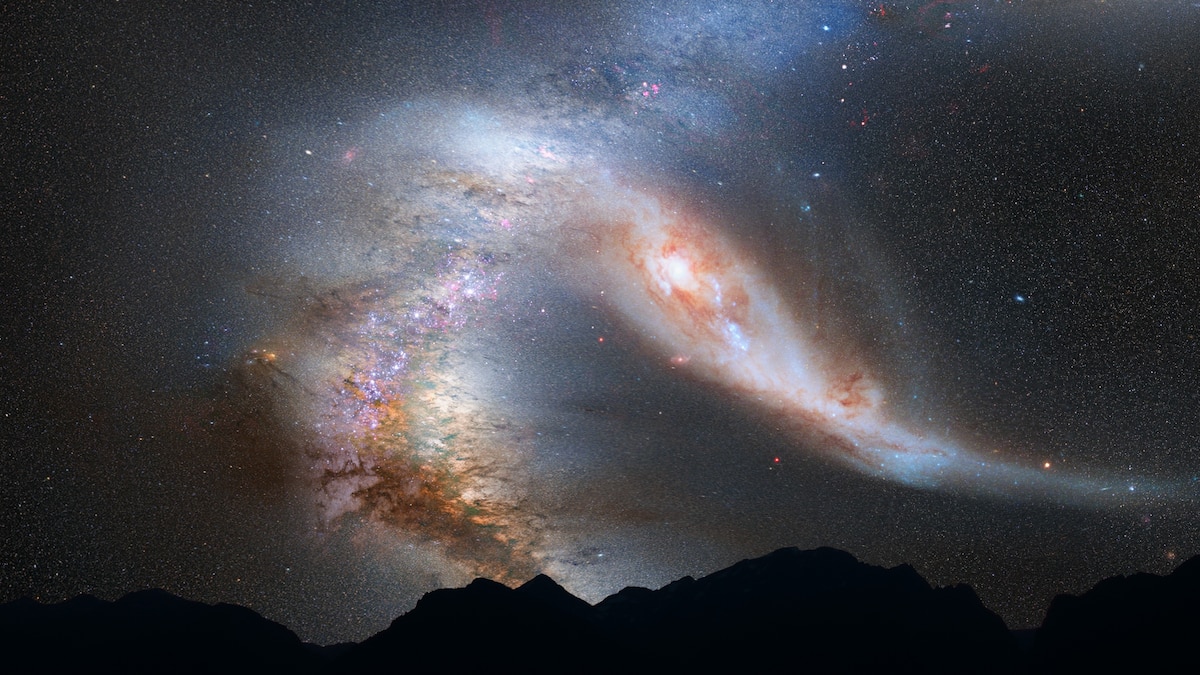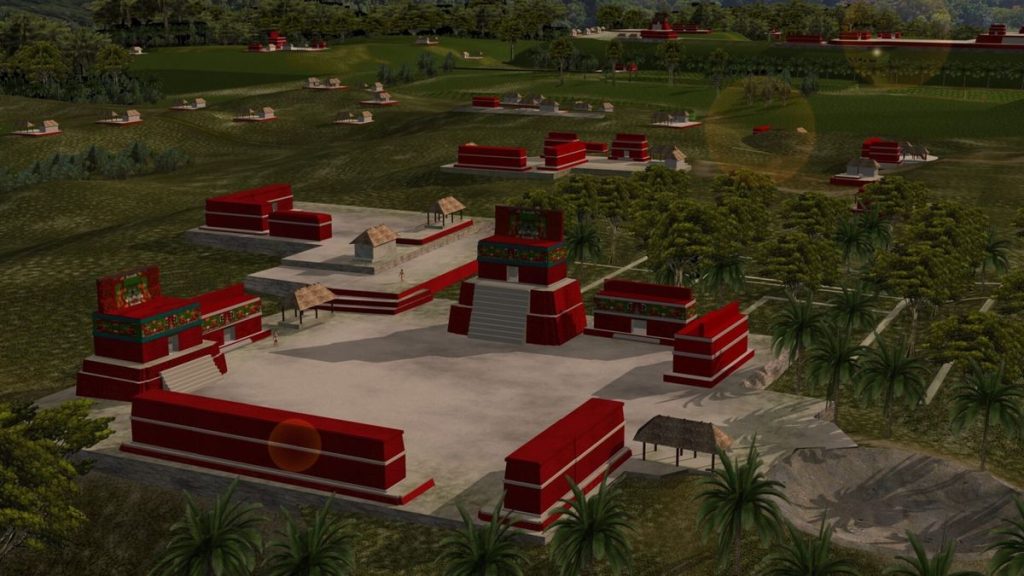Now Reading: Will the Milky Way crash into the Andromeda galaxy? Maybe not.
-
01
Will the Milky Way crash into the Andromeda galaxy? Maybe not.
Will the Milky Way crash into the Andromeda galaxy? Maybe not.

For more than a century, astronomers have watched the Andromeda galaxy, a massive swirl of neighboring stars, speed toward the Milky Way. And in recent years, measurements using the Hubble Space Telescope seemed to confirm a long-held prophecy: In about four or five billion years’ time, the two galaxies will clash, ultimately merging into a colossal and unrecognizable new galaxy.
A fresh survey of both galaxies and—crucially—several of the other weighty galaxies in the same corner of the cosmos has now cast doubt on that calamitous outcome. The new forecast looked billions of years into the future and found that the odds of an Andromeda and Milky Way merger is about fifty-fifty.
“A coin flip is the more accurate description,” says Till Sawala, an astrophysicist at the University of Helsinki and a co-author of the new study.
A messy galactic apocalypse is no longer a guarantee. As noted in the team’s new study, published today in the journal Nature Astronomy, “proclamations of the impending demise of our galaxy seem greatly exaggerated.”
Earth won’t be around in five billion years’ time; it’ll likely be scorched and swallowed up by our expanding, dying Sun. But if the Milky Way and Andromeda galaxies successfully swerve around one another, that’s good news for future worlds. A merger on this scale often sees the supermassive black holes at their hearts of each galaxy unify and expand into a fearsome, hyper-energetic astrophysical monster. That prevents nearby gas cooling down and gathering up to form new stars—and without new stars, you won’t get new planets.
The possibility of a galactic near-miss is “somehow comforting,” says Alister Graham, a galaxy researcher at the Swinburne University of Technology in Australia and who wasn’t involved with the new research. It’s nice to think the Milky Way “still has a long, planet-forming future ahead of it.”
This animation depicts the collision between our Milky Way galaxy and the Andromeda galaxy, which will merge into a single galaxy. The video also shows the Triangulum galaxy, which will join in the collision and perhaps later merge with the “Milkomeda” galaxy.
NASA, ESA, and F. Summers (STScI)
Galaxy merger mayhem
Astronomers witness galaxy mergers happening throughout all of space and time. Two similarly massive galaxies uniting is referred to as a major merger, whereas if a larger galaxy ingests a smaller one, it’s known as a minor merger.
Although some stars get torn apart by the extreme gravitational interactions of the two galaxies churning about—and some, including their planets, will be scattered like confetti in all directions—but the spaces between individual stars are so vast that most of them don’t collide. And although the smaller galaxies can vanish into the maws of the larger ones, the result is often constructive. “Minor mergers deliver both stars and gas—the raw material for future star formation—into the host galaxy. The stellar winds from newly formed stars enrich the interstellar medium with dust and metals, further fueling the star formation cycle,” says Graham. Even the Milky Way shows evidence of having been assembled via multiple galactic smash-ups.
“Up to 50 percent of the mass in galaxies today come from previous galaxies cannibalized,” says Christopher Conselice, an extragalactic astronomer at the University of Manchester in England and who wasn’t involved with the new research.

Andromeda is visible to the naked eye from Earth. Here it can be seen as a bright spot in the night sky rises above Tufa formations in Mono Lake, California.
Photograph by Babak Tafreshi, Nat Geo Image Collection

At 2.5 million light-years away, Andromeda, also known as M31, is our closest large galactic neighbor.
Photograph by ESA/NASA/JPL-Caltech/GBT/WSRT/IRAM/C. Clark (STScI)
Though astronomers have known that Andromeda is careening toward the Milky Way since the turn of the 20th Century, they weren’t sure how direct, or glancing, the clash would be. But in 2012, a landmark study using Hubble came to a definitive conclusion: Based on the motions of their stars, and the galaxies’ hefty masses, both would be gravitationally drawn into one another for a head-on collision in four to five billion years. (Later studies have come up with slightly earlier or later timelines for when the merger would happen, but never cast doubt on its inevitability.)
And about two billion years after the tempestuous major merger, the two ink-like star spirals would settle down and coalescence. “It would be an elliptical blob,” says Sawala.

Both galaxies can be visible in the night sky: The Milky Way, which stretches across the night sky from the constellations Cassiopeia to Cygnus, and the Andromeda Galaxy appears above this 3000-year old bristlecone pine tree.
Photograph by Babak Tafreshi, Nat Geo Image Collection
The notorious LMC
Since 2012, this outcome became gospel among the scientific community, and a textbook fact. “Should the Milky Way and Andromeda be all that matter—sorry about the pun—then they would be heading straight at each other,” says Graham.
You May Also Like
But the possibility of a future smash-up depends on the behavior of everything else in our Local Group, too: the panoply of at least 100 galaxies hanging about in this part of the universe. Other big galaxies in our neck of the woods might push or pull on the two voyagers over time.
Sawala’s team decided to simulate the evolution of the Milky Way and Andromeda galaxies ten billion years into the future. But while doing so, they also accounted for other major players in the Local Group: specifically, the spiral-shaped (and third-largest) Triangulum galaxy and the Large Magellanic Cloud (or LMC), an irregular galaxy that orbits the Milky Way.
The team used data from both Hubble and the European Space Agency’s stargazing Gaia space observatory to more precisely determine the motions of these galaxies, as well as their masses—comprised of both ordinary matter and the invisible, but more prevalent, dark matter.
Although the Triangulum Galaxy was already known to be quite massive, the LMC was thought to be a bit of a lightweight. But the new data suggest that it’s surprisingly massive—equivalent to 10 to 20 percent of the mass of the Milky Way. “And that will have an effect on how the Milky Way moves through space,” says Sawala.
The team simulated the motions of these four heavyweight galaxies thousands of times. While the Triangulum galaxy’s gravitational influence conspired to bring the Milky Way and Andromeda together, the LMC had a repellent effect. And when all four danced together, the odds of an eventual major merger was just one-in-two.

This scientific illustration of the Earth’s horizon 3.75 billion years in the future shows Andromeda filling the field of view and the Milky Way beginning to show distortion due to tidal pull from Andromeda.
Illustration by NASA, ESA, Z. Levay and R. van der Marel (STScI), T. Hallas, and A. Mellinger

A scientific illustration of the Earth’s horizon 3.85 to 3.9 billion years in the future shows the first close approach of Andromeda. The sky is ablaze with new star formation, which is evident in a plethora of emission nebulae and open young star clusters.
Illustration by NASA, ESA, Z. Levay and R. van der Marel (STScI), T. Hallas, and A. Mellinger
A galactic near-miss
“There are going to be uncertainties in how and when the Milky Way and Andromeda would merge,” says Conselice. Dark matter may act as a binding force. But dark energy, a mysterious force that seems to push everything the universe apart, will also play a role—and recent data suggests it’s strength can change over time. That makes forecasting a far-flung galactic merger somewhat tricky. But it’s safe to say that it’s no longer a certainty that these two galaxies will collide.
Some astronomers have suggested that if they do, the new galaxy could be named Milkomeda. That moniker doesn’t exactly roll off the tongue. Don’t worry, Sawala says: “We will have billions of years to think of a better name.”
Either way, galactic pandemonium will shape the Milky Way’s future. Even though the LMC is pushing Andromeda and our own galaxy apart, the team’s simulations also show with that, within the next two billion years, the LMC will spiral into us and be gobbled up by a merciless Milky Way.
“It’s basically 100 percent that this will happen,” says Sawala. “There’s no escaping that.”























